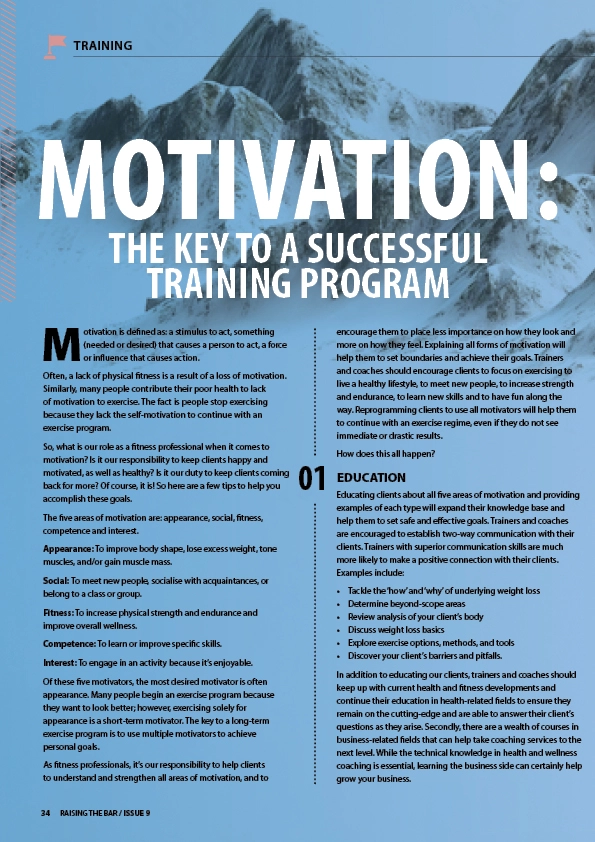training
Motivation: The Key to a Successful Training Program

Motivation is defined as: a stimulus to act, something (needed or desired) that causes a person to act, a force or influence that causes action.
Often, a lack of physical fitness is a result of a loss of motivation. Similarly, many people contribute their poor health to lack of motivation to exercise. The fact is people stop exercising because they lack the self-motivation to continue with an exercise program.
So, what is our role as a fitness professional when it comes to motivation? Is it our responsibility to keep clients happy and motivated, as well as healthy? Is it our duty to keep clients coming back for more? Of course, it is! So here are a few tips to help you accomplish these goals.
The five areas of motivation are: appearance, social, fitness, competence and interest.
Appearance: To improve body shape, lose excess weight, tone muscles, and/or gain muscle mass.
Social: To meet new people, socialise with acquaintances, or belong to a class or group.
Fitness: To increase physical strength and endurance and improve overall wellness.
Competence: To learn or improve specific skills.
Interest: To engage in an activity because it’s enjoyable.
Of these five motivators, the most desired motivator is often appearance. Many people begin an exercise program because they want to look better; however, exercising solely for appearance is a short-term motivator. The key to a long-term exercise program is to use multiple motivators to achieve personal goals.
As fitness professionals, it’s our responsibility to help clients to understand and strengthen all areas of motivation, and to encourage them to place less importance on how they look and more on how they feel. Explaining all forms of motivation will help them to set boundaries and achieve their goals. Trainers and coaches should encourage clients to focus on exercising to live a healthy lifestyle, to meet new people, to increase strength and endurance, to learn new skills and to have fun along the way. Reprogramming clients to use all motivators will help them to continue with an exercise regime, even if they do not see immediate or drastic results.
How does this all happen?
01. EDUCATION
Educating clients about all five areas of motivation and providing examples of each type will expand their knowledge base and help them to set safe and effective goals. Trainers and coaches are encouraged to establish two-way communication with their clients. Trainers with superior communication skills are much more likely to make a positive connection with their clients.
Examples include:
Tackle the ‘how’ and ‘why’ of underlying weight loss
Determine beyond-scope areas
Review analysis of your client’s body
Discuss weight loss basics
Explore exercise options, methods, and tools
Discover your client’s barriers and pitfalls.
In addition to educating our clients, trainers and coaches should keep up with current health and fitness developments and continue their education in health-related fields to ensure they remain on the cutting-edge and are able to answer their client’s questions as they arise. Secondly, there are a wealth of courses in business-related fields that can help take coaching services to the next level. While the technical knowledge in health and wellness coaching is essential, learning the business side can certainly help grow your business.
02. SOCIAL SUPPORT
Motivation and behaviour, in relation to eating and exercise, are influenced by a social support network. Social support includes companionship, encouragement, and assistance from friends, family members and co-workers, in addition to tangible advice, suggestions and positive reinforcement from trainers and coaches.
03. FITNESS
To help clients to be motivated through fitness, trainers are encouraged to provide an array of exercise options including equipment, free weights, body weight training, core conditioning, and small tools and props. In addition to exercise selection, a variety of training methods and techniques is highly suggested. Trainers should also assist clients to ensure proper alignment and form, to achieve greater results and decrease the risk of injury.
04. COMPETENCE
Motivating clients by consistently educating them in safe and effective training principles is crucial. Explaining the benefits of the exercise, the safety points of the exercise, and ways to modify or change the exercise is highly recommended. Stimulating clients by commenting on their improvement and performance will raise their self-esteem and help them to use the competence motivator. Additionally, each time they participate in a training session they’ll learn more about their body and improve body awareness.
05. INTEREST
Lastly, we want our clients to enjoy what they’re doing while benefitting from an exercise regime. This can be obtained by introducing new exercises and a variety of equipment, tools, and props. Additionally, incorporating a variety of training methods and techniques will help to avoid exercise burnout and boredom. Keeping our clients engaged will keep them coming back for more and, eventually, achieving their fitness goals.
As fitness professionals, it is our responsibility to help our clients stay motivated. By educating our clients in all motivation areas, they will improve their fitness level, notice a remarkable difference in how they feel and look, and therefore stick with their exercise program. Motivation really is the key to success in any endeavour.


Lisa J. Hamlin
Lisa is an holistic health practitioner, AFAA Master instructor and international educator with more than 30 years’ experience in the health and wellness industry. Find out more at assured-fitness.com.